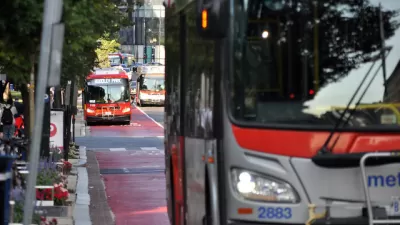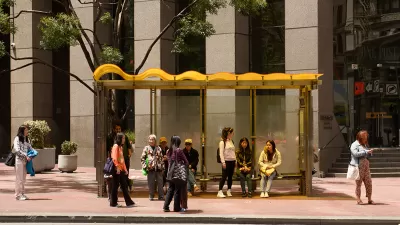A new report, "Subsidizing Traffic Congestion: The Multibillion-Dollar Tax Subsidy That’s Making Your Commute Worse," was released earlier this week by TransitCenter and Frontier Group.
According to Tanya Snyder at Streetsblog USA, the "Subsidizing Traffic Congestion: The Multibillion-Dollar Tax Subsidy That’s Making Your Commute Worse" report by TransitCenter and the Frontier Group finds that the annual parking commuter tax subsidy costs taxpayers an estimated $7.3 billion in foregone revenue. In addition, this backwards incentive adds an additional 820,000 cars to commuting rush-hour traffic each weekday, creating more congestion and lost productivity.
In January 2014, Congressional action caused the commuter transit benefit to fall to $130 each month from one's pre-tax benefits, if driving benefits are $245 per month. As Snyder writes, "[most] advocacy efforts centered on commuter tax subsidies attempt to raise the transit benefit — currently capped at $130 per month. Last week, for instance, two members of Congress pledged to fight for an equal commuter benefit for transit and parking. TransitCenter and the Frontier Group argue that this is the bare minimum to strive for. The real impact lies in simply getting rid of the parking benefit."
Indeed, "TransitCenter and Frontier Group estimate that while most people don’t change their commuting behavior based on the incentives created by these tax benefits, about 2 percent do — and that 2 percent drives 4.6 billion additional miles per year. To make matters worse, they do that extra driving at peak hours, in crowded downtown areas, worsening congestion that the country’s transportation policy is supposedly oriented toward fixing."
The report recommends eliminating the parking tax benefit, making federal support for transit more progressively equitable, and improving and expanding the current transit tax benefit.
FULL STORY: The Parking Tax Benefit: A $7.3 Billion Subsidy for Traffic Congestion

Study: Maui’s Plan to Convert Vacation Rentals to Long-Term Housing Could Cause Nearly $1 Billion Economic Loss
The plan would reduce visitor accommodation by 25,% resulting in 1,900 jobs lost.

Alabama: Trump Terminates Settlements for Black Communities Harmed By Raw Sewage
Trump deemed the landmark civil rights agreement “illegal DEI and environmental justice policy.”

North Texas Transit Leaders Tout Benefits of TOD for Growing Region
At a summit focused on transit-oriented development, policymakers discussed how North Texas’ expanded light rail system can serve as a tool for economic growth.

Paris Bike Boom Leads to Steep Drop in Air Pollution
The French city’s air quality has improved dramatically in the past 20 years, coinciding with a growth in cycling.

Why Housing Costs More to Build in California Than in Texas
Hard costs like labor and materials combined with ‘soft’ costs such as permitting make building in the San Francisco Bay Area almost three times as costly as in Texas cities.

San Diego County Sees a Rise in Urban Coyotes
San Diego County experiences a rise in urban coyotes, as sightings become prevalent throughout its urban neighbourhoods and surrounding areas.
Urban Design for Planners 1: Software Tools
This six-course series explores essential urban design concepts using open source software and equips planners with the tools they need to participate fully in the urban design process.
Planning for Universal Design
Learn the tools for implementing Universal Design in planning regulations.
Smith Gee Studio
Alamo Area Metropolitan Planning Organization
City of Santa Clarita
Institute for Housing and Urban Development Studies (IHS)
City of Grandview
Harvard GSD Executive Education
Toledo-Lucas County Plan Commissions
Salt Lake City
NYU Wagner Graduate School of Public Service




























